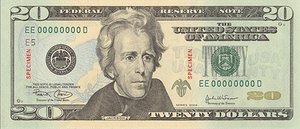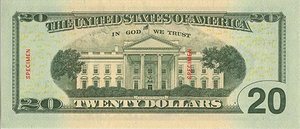U.S. twenty-dollar bill
|
|
The U.S. twenty dollar bill ($20) is a denomination of United States currency. U.S. President Andrew Jackson is currently featured on the front side of the bill, while the White House is featured on the reverse side.
Twenty dollar bills are delivered by Federal Reserve Banks in violet straps. The $20 bill is the primary banknote dispensed by automated teller machines in the United States; it is, therefore, the highest denomination used by Americans on a regular, everyday basis.
The Bureau of Engraving and Printing says the "average life" of a $20 bill in circulation is 25 months before it is replaced due to wear.
| Contents |
Pre-Federal Reserve history
- 1861: A demand note with Lady Liberty holding a sword and shield on the front, and an abstract design on the back. The back is printed in green.
- 1862: A note that is very similar, the first $20 United States note. The back is different, with several small variations extant.
- 1863: A gold certificate $20 note with an Eagle vignette on the face. The reverse has a $20 gold coin and various abstract elements. The back is orange.
- 1865: A national bank note with "The Battle of Lexington" and "Columbia Leading a Procession" on either side of the face and obligation text conspicuously in the middle. The reverse features "The Baptism of Pocahontas" in black, and a green border.
- 1869: A new United States note design with Alexander Hamilton on the left side of the front and Victory holding a shield and sword. The back design is green.
- 1875: As above, except with a different reverse.
- 1878: A silver certificate $20 note with a portrait of Stephen Decatur on the right side of the face. The back design is black.
- 1882: A new gold certificate with a portrait of James Garfield on the right of the face. The back is orange and features an eagle.
- 1882: A new national bank note. The front is similar, but the back is different and printed in brown.
- 1886: A new silver certificate $20 note with David Manning on the center of the face.
- 1890: A treasury (coin) note with John Marshall on the left of the face. Two different backs exist: both with abstract designs.
- 1902: A new national bank note. The front design features Hugh McCulloch, and the back has a vignette of an allegorical America.
- 1905: A new gold certificate $20 note with George Washington on the center of the face. The back design is orange.
- 1918: A federal reserve bank note with Grover Cleveland on the front, and a back design similar to the 1914 Federal Reserve Note.
Federal Reserve history
- 1914: Began as a large-sized note with a portrait of Grover Cleveland on the face, and, on the back, a steam locomotive approaching from the left, and a steamship approaching from the right
- 1928: Switched to a small-sized note with a portrait of Andrew Jackson on the face and the south view of the White House on the reverse. The banknote is redeemable in gold or silver (at the bearer's discretion) at any Federal Reserve Bank.
- 1934: The obligation is changed. The bill is no longer redeemable in gold, but rather in "lawful currency". This is due to the U.S. being taken off of the gold standard. "Lawful currency" in this case ends up meaning silver.
- 1943: A special emergency series, with brown serial numbers and "HAWAII" overprinted on both the front and the back, is issued. These notes are designed to circulate on the islands, and be deemed invalid in the event of a Japanese invasion.
- 1948: The White House picture was updated to reflect renovations to the building itself as well as the passage of time. Most notably, the trees are larger.
- 1950: Design elements like the serial numbers are reduced in size and moved around subtly, presumably for aesthetic reasons.
- 1963: "Redeemable in Lawful Currency" is replaced by "In God We Trust". The two acts (one taking U.S. currency off silver backing, and the other authorising the national motto) are coincidental, even if their combined result is implemented in one redesign. There is a subtle irony to be found, especially to those that oppose fiat currency. Also, several design elements are rearranged, less perceptibly than the change in 1950, mostly to make room for the slightly rearranged obligations.
- 1969: The new treasury seal appears on all denominations, including the $20.
- 1977: A new type of serial-number press results in a slightly different font. The old presses are gradually retired, and old-style serial numbers appear as late as 1981 for this denomination.
- 1990: Anti-counterfeiting features are added: microprinting around the portrait, and a plastic strip embedded in the paper.
- September 24, 1998: Received a completely new appearance to further deter counterfeiting; the picture of the White House was changed to the north side view. A larger, off-center portrait of Jackson was used on front, and several anti-counterfeiting features were added, including color-shifting ink, microprinting, and a watermark.
- October 9, 2003: Still another new appearance with light background shading in blue and yellow, and no oval around Andrew Jackson's portrait (background images of eagles, etc. were also added to the front); the back is the same view of the White House, but without the oval around it (many tiny, faint "20"s scattered on in the background on the back in yellow). The series date is 2004.
Related small-sized notes
The 1928 design was made both as a Federal Reserve Note and also a Gold Certificate. The design work is identical, but the obligations are different. Both are black on the front, and green on the back, but the Federal Reserve Note has green serial numbers, and the Gold Certificate has yellow. There is also a Series of 1929 National Bank Note and Federal Reserve Bank Note, which have the same back design and a similar front design.
Unmade bills
Several unmade twenty-dollar bills are known. Most are similar in design to the ones described above, with the only difference being certain obligations. For example, a silver-certificate variety of the 1928 style Federal Reserve Note is known in the proof stage, with blue serial numbers. More interesting examples include a 1923 Federal Reserve Note, with Grover Cleveland as on the Series of 1914, but different border elements, an 1873 National Bank note whose design is unknown, and also an 1896 Silver Certificate.
The $20 bill is sometimes nicknamed a "double-sawbuck," although this usage is far less common today than it was in the early 20th century.
See also
- Twenty Bucks, a 1993 movie that follows the travels of a $20 bill
External links
- Photos of historical $20 bills (http://www.currencygallery.org/denoms/20dollar.htm)
- How to fold a $20 bill to show images of the September 11 terrorist attacks (http://snopes.com/rumors/20bill.htm)
| United States currency and coinage |
| Topics: Federal Reserve note | United States Notes | United States coinage | United States dollar |
| Currency: $1 | $2 | $5 | $10 | $20 | $50 | $100 | Larger denominations |
| Coinage: Cent | Nickel | Dime | Quarter | Half-dollar | Dollar |


